Database model for a hierarchical content
9 min read ·
You’re probably familiar with multi-level comments sections such as on Facebook, Reddit, or Hackernews — a user can reply to a post, and the system allows multiple levels of nested replies. I recently needed to implement it myself for a side project, and I found a few ways of modeling the database, with different complexities and tradeoffs. In this article, I’m going to cover a few of them.
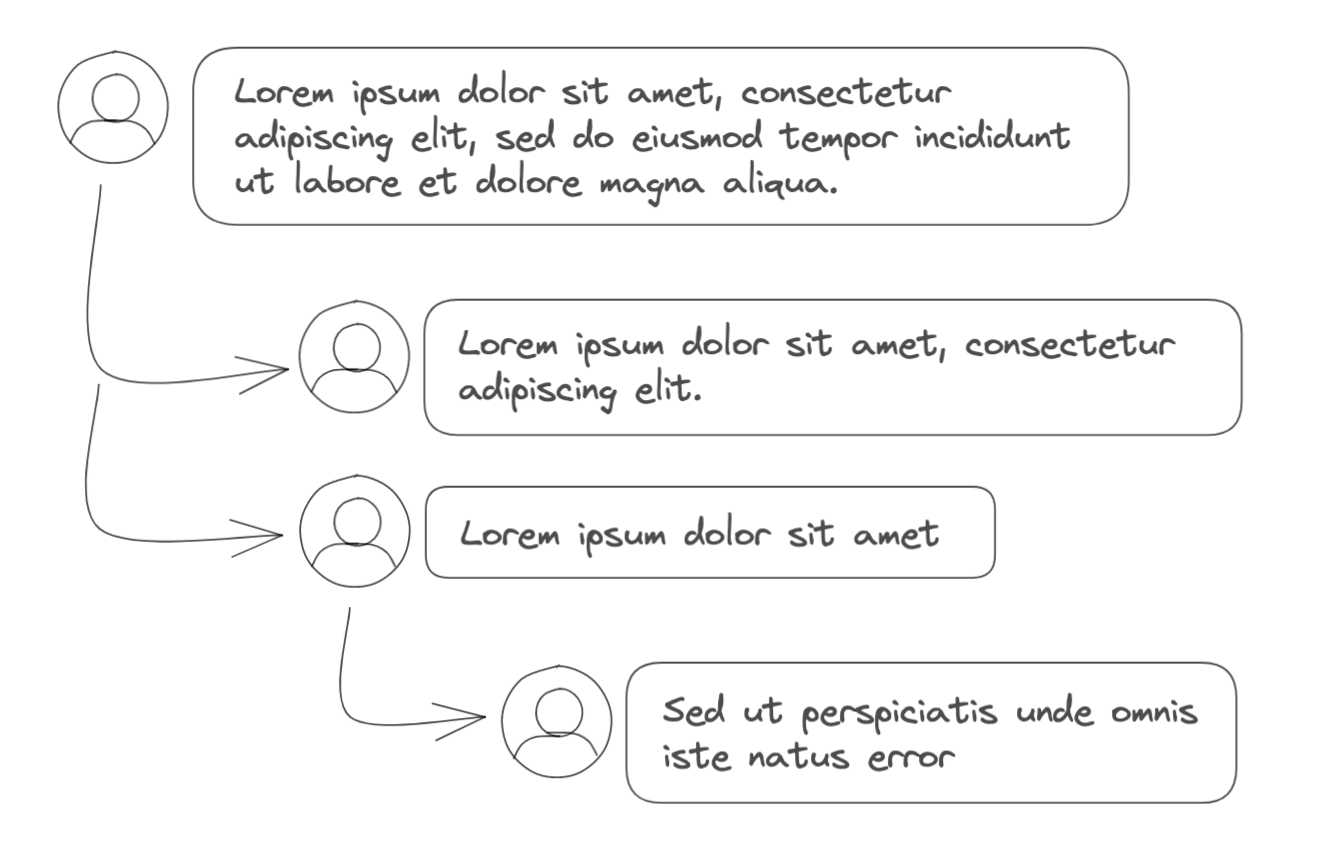
Note: all the SQL examples will be in Postgres, but you can find equivalent solutions in many other relational databases. Also, the queries here are not optimized and production-ready — the goal is to show the idea, but you’ll need to modify them to fit your use case.
Current schema
In the picture below, you can see the initial schema that I will use in
examples. There’s a Comments table that stores whatever information we need.
For the sake of example, I reduced it to five columns.
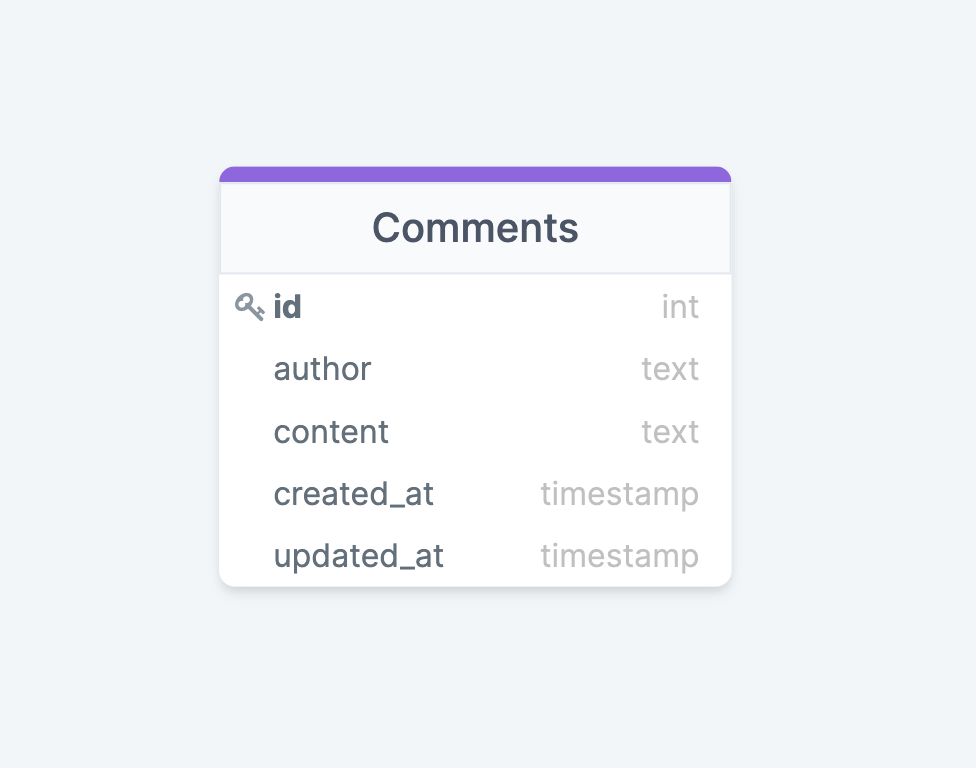
Comments with 1-level deep replies
Before diving into multi-level comments, I want to cover a less complex but popular version — 1-level deep replies. You can find it, for example, on Linkedin or Instagram. In this case, each “base” comment can have multiple replies, but you can’t respond to a reply.
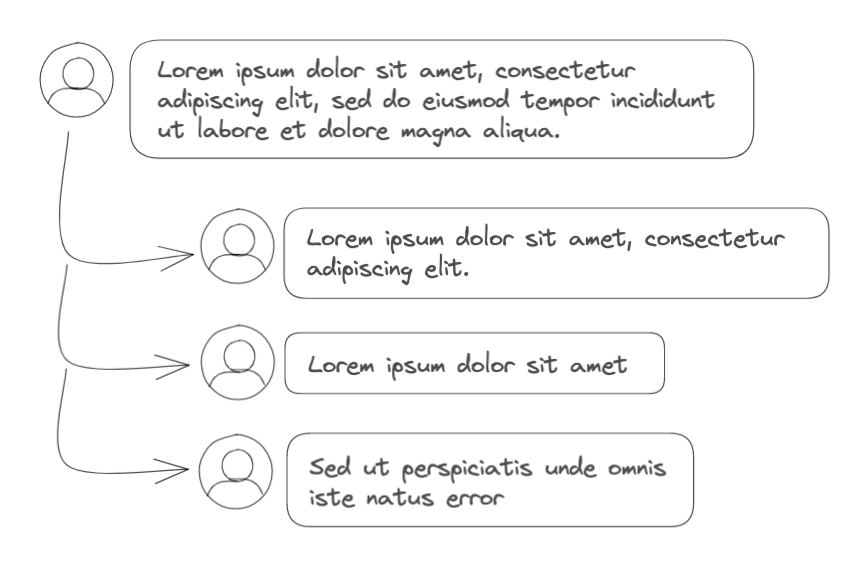
We can extend the Comments table by adding a parent_id column to implement
this scenario. The new column will have a foreign key relation to the id column.
It’ll be a many-to-one relation, which means a comment can have multiple
comments (replies) that point to it as their parent.
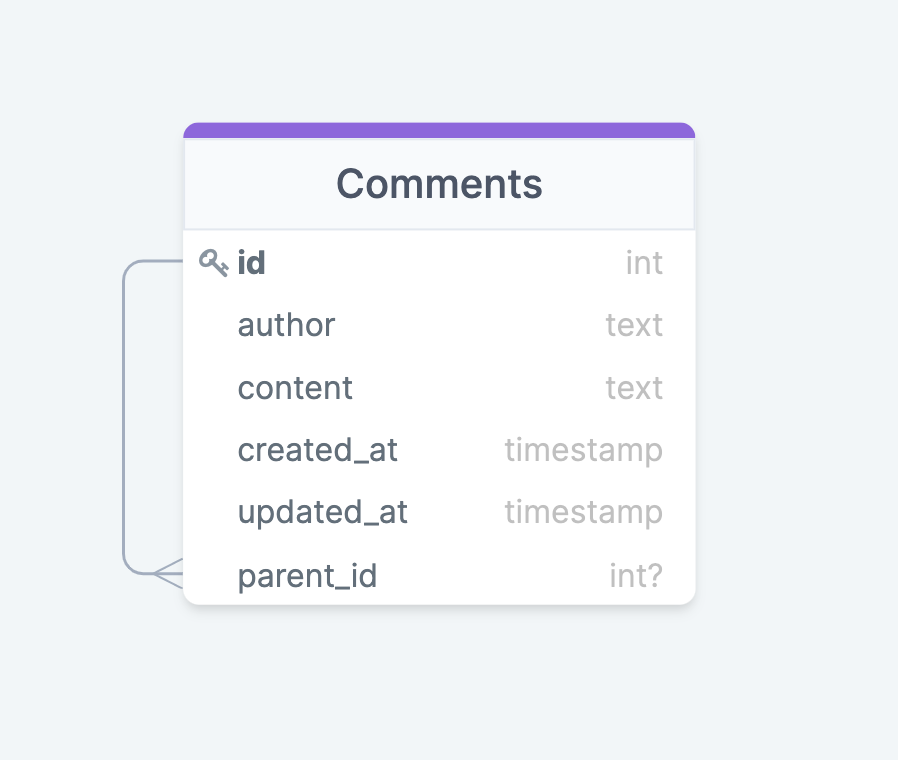
What happens when a user replies to comment with id 1? We add a new row, with
parent_id equal to 1. Now, how do we fetch the comments? It’s pretty flexible
and depends on what you want to achieve in the UI.
If you want to fetch only the “base” comments (not the replies), you can select
everything from the Comments table where parent_id is NULL. You can then
refetch the responses by selecting those entries that match a particular value
in the parent_id column.
sql
sql
However, if you want to fetch all the comments with the replies at once, you can do it with a little bit more complex SQL query. There are many ways to fetch this data, and it mostly depends on what shape you want on the front end. For example, to have replies as an object, you can do something like this in Postgres:
sql
sql
If you use GraphQL it could look like this:
graphql
graphql
It was one of the ways to have 1-level deep replies, and I’ll stop here to move the main topic of this article — multi-level replies.
Multi-level replies
Choosing the suitable data model and implementation depends not only on the ease
of the backend implementation but also on the frontend. How exactly the comments
are shown on the UI can influence the DB model decisions. Let’s say the design
states that we don’t need all the nested replies at once but instead have a
show replies button. In this case, maybe we can use a different backend
implementation than when we need all the nested comments and responses at once.
After all, the show replies approach is quite common (Facebook), and maybe
it’ll be the case for your app as well? Let’s consider this approach first.
Without fetching the replies at once
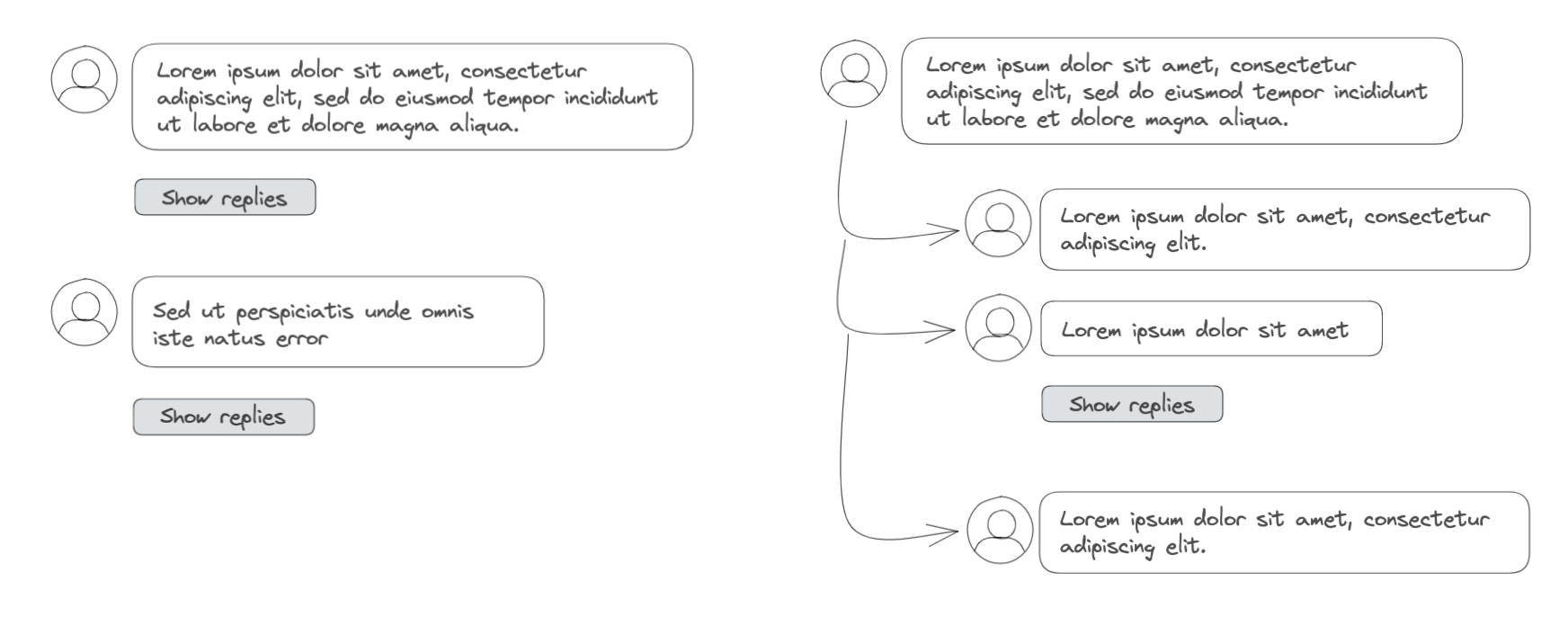
We already mentioned refetching the replies for a particular comment when discussing the 1-level comments. We’ll stay with the same schema as before:

This scenario is not much different but can have multiple approaches:
-
We fetch only the base comments and have a show replies button below each. After a user clicks the
show repliesbutton, we fetch the replies and then each reply will have itsshow repliesbutton. And then it can be as nested as you want. You can use the same queries as we mentioned earlier. -
We can also bring a bit more data at first — the base comments and 1-level replies, and then we have a button below each reply.
-
We fetch the base comments and a maximum of one reply to each, with the
show morebutton to get all the replies. It can also happen on a more nested level.
The takeaway here is that it’s all possible with a simple database model having a self-referencing table, and we can fetch the data with a few short queries. However, it’s not always enough, and in case you need all the nested replies, it’s getting a bit more complicated. In the following sections, I’m going to cover two, in my opinion, quite nice ways to deal with it.
Using a common recursive expression
Common table expressions allow you to create a helper query that you can use in the main query. You can think of it as a temporary table to use within a SELECT, INSERT, UPDATE, or DELETE statement. Here’s an example:
sql
sql
It’s the same query we used before for getting comments and replies but written using a common table expression.
Now, a recursive common table expression can reference itself, which is helpful when querying hierarchical data, e.g. nested comments!
How we’re going to use it?
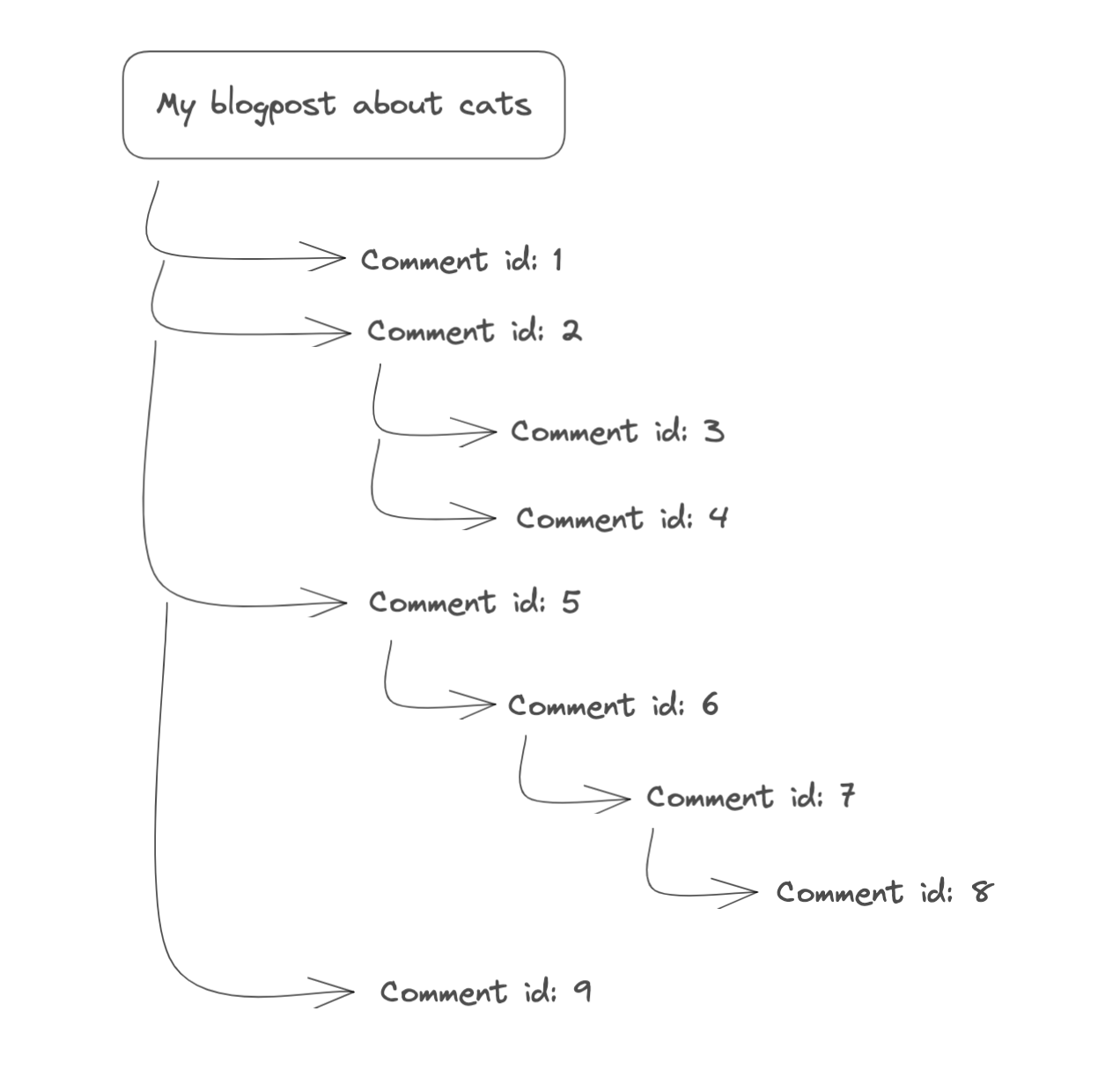
Take a look at the diagram above. My blogpost about cats has four base comments (id: 1, 2, 5, 9), the second one has two replies (id: 3, 4), and the third comment has 3-level deep replies.
Let’s say we want to fetch the comments and all of their replies. The tricky part here is calculating the hierarchies. It sounds like a lot of mapping through the list to obtain the comments tree as an object. That’s when a recursive table expression can help. We can construct a query to get results with the hierarchy collected as a path. The base comment will have an empty path as it doesn’t have a parent, and the replies will have it constructed from the previous comments’ ids.
For example, from data as on the above diagram, comment number 8 would have a
path of value /5/6/7.
sql
sql
The above query recursively constructs the comment’s path by repeated joins with
self (a comments_cte table). It returns the comments’ id, path, content, and
author.
If we run this query on the data from the diagram, we’ll see the following result:
| id | path | … |
|---|---|---|
| 1 | … | |
| 2 | … | |
| 3 | /1 | … |
| 4 | /1 | … |
| 5 | … | |
| 6 | /5 | … |
| 7 | /5/6 | … |
| 8 | /5/6/7 | … |
| 9 | … |
Now imagine that you have pagination and need only ten comments and all of their replies. Getting ten “base” comments should be okay, but the tricky part here is to know what other comments are descendants of these ten — which ones are replies (or nested replies). The approach with a recursive CTE helps a bit with calculating the hierarchies. Still, it’s pretty complex in terms of extendability — it can get out of hand when adding pagination on top of that. That’s the way I’m going to show another approach that may solve this problem.
Using an additional path column
Since we already spoke about paths, we can think about another solution that
doesn’t require calculating them while fetching the comments. We can modify the
schema by removing the foreign key relation and adding a new path column.
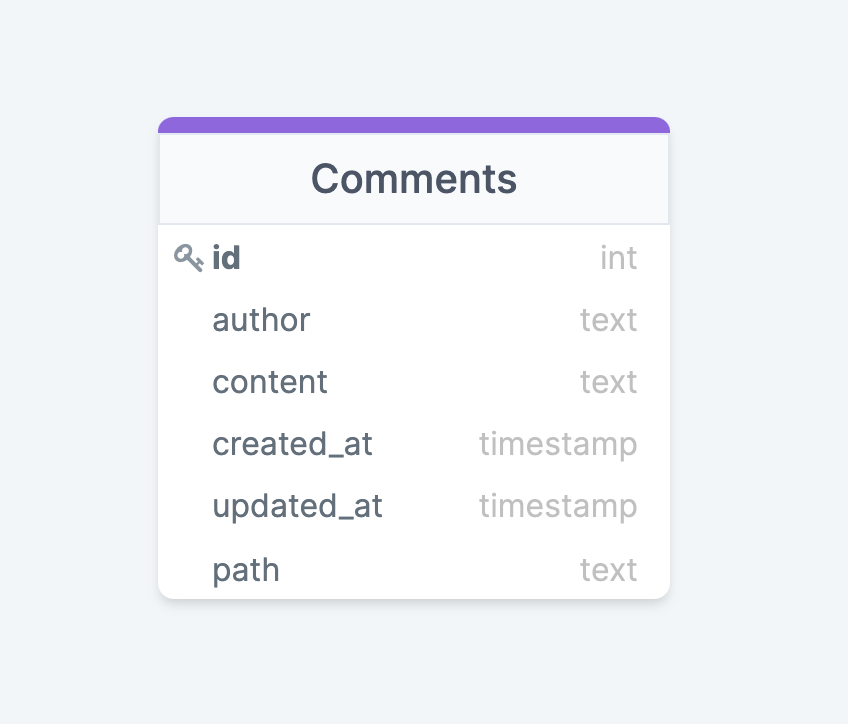
New schema means we need to change the way of adding new comments to the database. When inserting a new row, we need to pass a calculated path. It should be pretty straightforward if you have the information to which comment a user is replying and the hierarchy on the front end.
Regarding fetching the comments, you can query all of the entries if you need all of them. However, if you need pagination, this solution can be a good fit. Let’s say you select ten “base” comments per page and all the nested replies of these ten comments. In such a case, the query should select ten entries with an empty path and all entries where the path starts with the selected base comments.
sql
sql
I used a CTE again in this query mostly because I like using it 😅, but you can manage perfectly well without it!
You need to remember that the text column has a limit. Though, it’s big enough
that it shouldn’t be a problem unless you have A LOT of nested levels and/or use
long strings to represent comments’ ids.
Using ltree
If you’re using Postgres, you might be interested in checking out a ltree data type. It represents labels of data stored in a hierarchical tree-like structure. Postgres provides many ltree operators to search through the hierarchical data, for example, searching for ancestors or descendants.
A ltree’s label is a sequence of alphanumeric characters and underscores less
than 256 bytes long. A label path is a sequence of labels separated by dots,
e.g. 1.2.3.
To use this data type, we need to add an extension to Postgres and create a new column:
sql
sql
We can then use a <@ operator to get all nested replies of a particular
comment:
sql
sql
Here you can read more about a comparison between a recursive CTE and ltree.
Note: In the previous examples, we were using comments’ ids for paths. However, suppose you’re using strings such as UUID for it. In that case, you might need an additional way of representing comments unique identifiers as ltree’s label should only have alphanumeric characters and underscores.
Summary
As I mentioned before, choosing a suitable model depends on many things — each
application has different requirements and cares about different things. In this
article, I only showed a few options that I’ve been looking at myself recently.
However, other ways of handling multi-level comments may be a much better option
in your particular use cases. Maybe a bridge table storing all the relations is
a right fit for your app? Or perhaps you don’t want to use a relational database
and have a totally different way of dealing with this problem? Choosing the
right solution also depends on your current database and its supported features
(good luck with working with jsons in MS SQL server 😅). Though, if you use MS
SQL Server, you might be interested in
hierarchyid data type.
I’d be happy to hear about your solutions — you can reach out to me via Twitter!